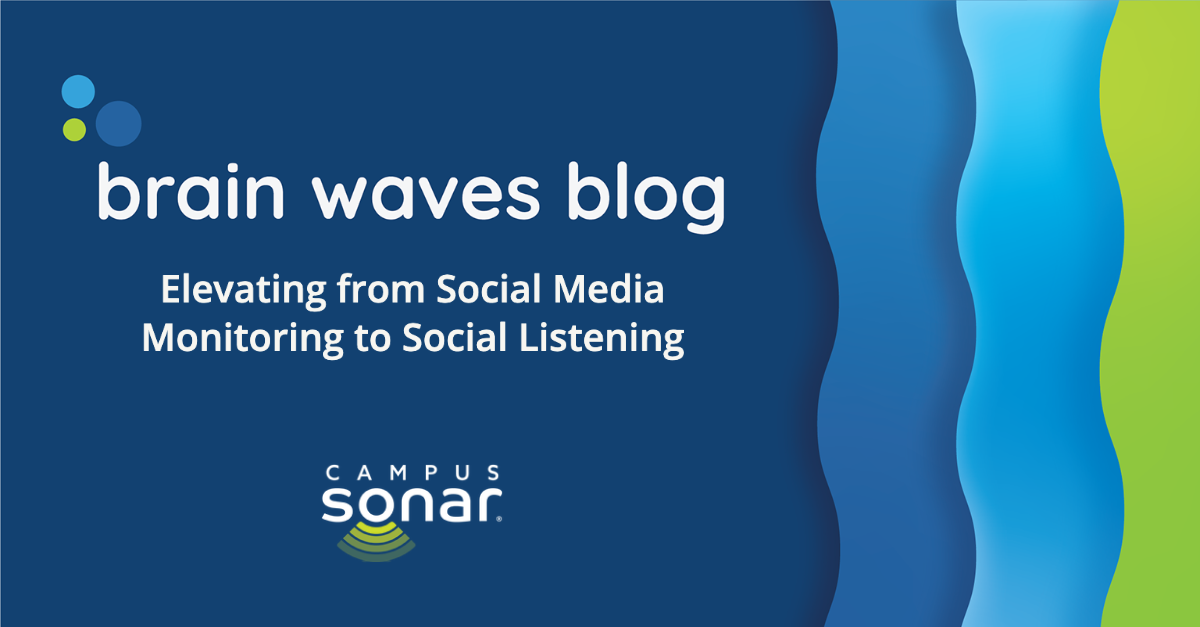Elevating from Social Media Monitoring to Social Listening

Monitoring and listening seem like the same thing, right? It can be hard to understand the difference between these two activities. You’ve probably even used the words interchangeably. We’re here to tell you there are critical differences between them; differences that prove monitoring alone is not enough. Once you start listening, you’ll realize the moments and opportunities you missed when you thought you were listening.
Social Media Monitoring
Most campuses do some version of social media monitoring. You watch for posts to your Facebook page and direct tags and exact-match plain-text mentions on your official campus accounts on Twitter or Instagram. This is important work and a necessity for responsive customer service. It’s like checking email or responding when someone calls your name. Not watching your accounts and responding to tags would be bad business and just plain rude.
Social media monitoring is often accomplished through social media management software, like Sprout Social or Hootsuite, or manually through native social media networks. But in this scenario you're still only searching for the topics and themes you're already aware of. What about the issues that aren’t on your radar yet?
Because social media monitoring and social media management are interconnected, social media monitoring offers limited reporting capabilities on its own. Mentions caught via social monitoring are folded into standard social media reporting metrics, the metrics social platforms want you to report on, regardless of how well they align with your strategic priorities.
Social Listening
Social listening dives deeper than monitoring in terms of the depth and breadth of conversations discovered. With more than 100 million data sources available to crawl, listening finds mentions on websites that extend far beyond social platforms. This advanced method for finding conversations enables you to search for mentions of your brand that reference you by nickname, abbreviations, mascots, etc., rather than exact-match mentions.
But there’s more to it than that. Social listening takes a giant, custom dataset and analyzes it in a variety of different ways in order to make observations, detect patterns, and develop insights. In this way, it gives you an authentic and unfiltered view into your audience’s questions, opinions, celebrations, anxieties, and fears.
This wide net of data provides a framework for measuring all of the conversation about your campus, allowing you to build KPIs and reporting metrics that tie back to the ROI of your initiatives and help you make more data-driven decisions moving forward.
One of the most common strategic uses for social listening is brand and reputation management. Understanding all of your online conversation helps you learn how your audience perceives your campus so you can change the narrative and create stronger brand alignment between reality and perception.
| Social Monitoring | Social Listening | |||
| Monitoring mentions and DMs. | Observing, collecting, measuring, and analyzing public web content for mentions or conversations of interest. | |||
| Platforms |
|
|
||
|
Measuring & Reporting |
Point-in-time social platform metrics:
|
Relational metrics analyzing trends over time:
|
||
| Actionable Takeaways |
|
|
||
Humans Using Software vs. Software Alone
Social listening software identifies and analyzes individual digital and social media posts. A good social listening tool offers more operators, allowing you to find a higher variation of mentions.
If that second sentence lost you it’s because social listening isn’t something just anyone can (or should) do—to best use software, you need training, dedicated staff, and a comprehensive strategy to create and execute queries to get the most relevant data about your campus.
That includes finding references to your campus when you’re mentioned and tagged and also when you’re mentioned and not tagged. When you’re mentioned in relation to your top competitive campuses. When a prospective student asks what life is like at your campus but only identifies you by one of your nicknames. When an admitted student with a significant social media following is an influential voice on your campus.
We hear from clients that many software platforms claiming to have social listening capabilities are lacking in numerous areas, from simple tasks like missing mentions to more complex needs like custom dashboards or insightful reporting. Some of that is functionality, but a lot of it is because software alone isn’t the answer.
The Role of Data Analysts in Social Listening Strategy
Human analysts like ours are experts in the skills needed to optimize social listening software. They contextualize the data points and create the larger story about your brand and dig deeper when they spot anomalies or irregularities, ensure relevancy by validating and cleaning data, add context, identify crises, and detect nuance.
Throughout the process, they make critical analytical decisions to ensure analysis aligns with project goals and questions.
For example, think about references to your campus. You’re not just known as “Sampleton Northern University.” Sometimes you’re known by Sampleton or Sampleton Northern, misspellings like Samplton, your mascot, or “SNU.” The query our analysts build reflects all the ways people refer to your campus to bring in data that reflects that variety. They use information provided by your campus and online searches to capture all of the conversation about your campus, topics, themes, and ideas you may never have even thought of.
Data these days is easy to come by, but an expert lens to review that data is harder to find or to resource within a team. But it’s worth the effort, whether you get the software and hire and train staff or find an agency like us to work with. It’s time for higher ed to move beyond monitoring and tracking simple metrics. Your audiences are out there, talking about you. You should listen.

